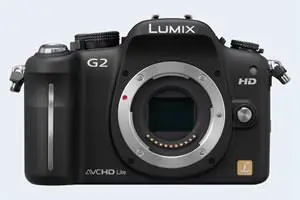Nikon L840 vs Panasonic G2
The Nikon Coolpix L840 and the Panasonic Lumix DMC-G2 are two digital cameras that were revealed to the public, respectively, in February 2015 and March 2010. The L840 is a fixed lens compact, while the G2 is a mirrorless interchangeable lens camera. The cameras are based on a 1/2.3-inch (L840) and a Four Thirds (G2) sensor. The Nikon has a resolution of 15.9 megapixels, whereas the Panasonic provides 12 MP.
Below is an overview of the main specs of the two cameras as a starting point for the comparison.

Check L840 offers at
ebay.com

Check G2 offers at
ebay.com
Going beyond this snapshot of core features and characteristics, what are the differences between the Nikon Coolpix L840 and the Panasonic Lumix DMC-G2? Which one should you buy? Read on to find out how these two cameras compare with respect to their body size, their imaging sensors, their shooting features, their input-output connections, and their reception by expert reviewers.
Body comparison
The physical size and weight of the Nikon L840 and the Panasonic G2 are illustrated in the side-by-side display below. The two cameras are presented according to their relative size. Three successive views from the front, the top, and the rear are shown. All width, height and depth measures are rounded to the nearest millimeter.
The L840 can be obtained in two different colors (black, red), while the G2 is available in three color-versions (black, blue, red).
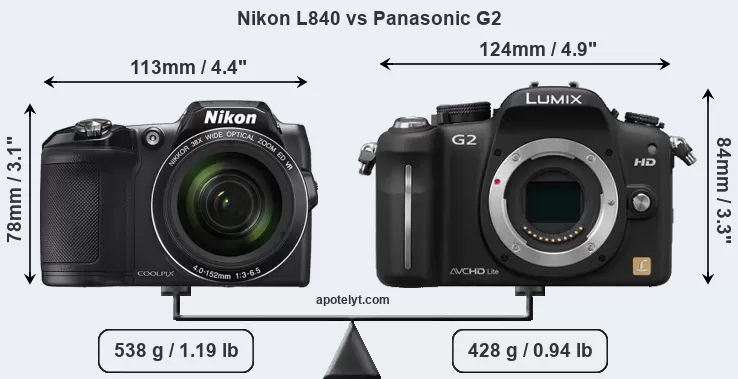
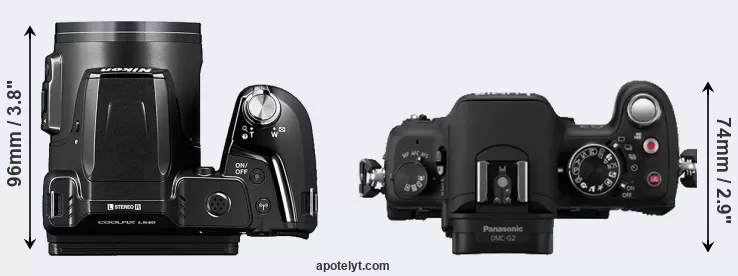
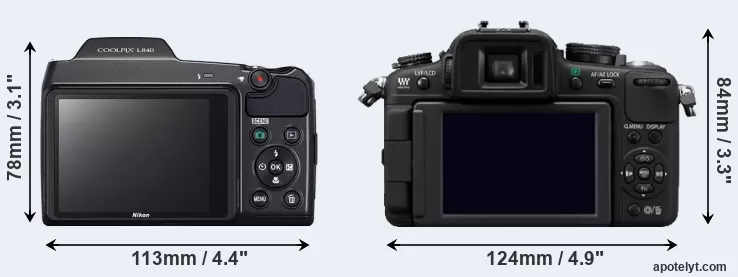
If the front view area (width x height) of the cameras is taken as an aggregate measure of their size, the Panasonic G2 is notably larger (18 percent) than the Nikon L840. In this context, it is worth noting that neither the L840 nor the G2 are weather-sealed.
The above size and weight comparisons are to some extent incomplete and possibly misleading, as the L840 has a lens built in, whereas the G2 is an interchangeable lens camera that requires a separate lens. Attaching the latter will add extra weight and bulk to the setup. You can compare the optics available for the G2 and their specifications in the Micro Four Thirds Lens Catalog.
The table below summarizes the key physical specs of the two cameras alongside a broader set of comparators. In case you want to display and compare another camera duo, you can use the CAM-parator app to select your camera combination among a large number of options.

| # | Camera Model |
Camera Width |
Camera Height |
Camera Depth |
Camera Weight |
Battery Life |
Weather Sealing |
Camera Launch |
Launch Price (USD) |
Street Price |
|
|---|---|---|---|---|---|---|---|---|---|---|---|
| 1. | Nikon L840 | 113 mm | 78 mm | 96 mm | 538 g | 590 | n | Feb 2015 | 299 | ebay.com | |
| 2. | Panasonic G2 | 124 mm | 84 mm | 74 mm | 428 g | 360 | n | Mar 2010 | 599 | ebay.com | |
| 3. | Canon SX530 | 120 mm | 82 mm | 92 mm | 442 g | 210 | n | Jan 2015 | 429 | ebay.com | |
| 4. | Canon SX520 | 120 mm | 82 mm | 92 mm | 441 g | 210 | n | Jul 2014 | 399 | ebay.com | |
| 5. | Canon SX60 | 128 mm | 93 mm | 114 mm | 650 g | 340 | n | Sep 2014 | 549 | ebay.com | |
| 6. | Nikon B600 | 122 mm | 82 mm | 99 mm | 500 g | 280 | n | Jan 2019 | 349 | ebay.com | |
| 7. | Nikon B700 | 125 mm | 85 mm | 107 mm | 565 g | 350 | n | Feb 2016 | 499 | ebay.com | |
| 8. | Nikon B500 | 114 mm | 78 mm | 95 mm | 541 g | 600 | n | Jan 2016 | 299 | ebay.com | |
| 9. | Nikon P900 | 140 mm | 103 mm | 137 mm | 899 g | 360 | n | Mar 2015 | 599 | ebay.com | |
| 10. | Panasonic G3 | 115 mm | 84 mm | 47 mm | 336 g | 270 | n | May 2011 | 599 | ebay.com | |
| 11. | Panasonic G10 | 124 mm | 84 mm | 74 mm | 388 g | 380 | n | Mar 2010 | 499 | ebay.com | |
| 12. | Panasonic GH2 | 124 mm | 90 mm | 76 mm | 442 g | 330 | n | Sep 2010 | 899 | ebay.com | |
| 13. | Panasonic GH1 | 124 mm | 90 mm | 45 mm | 385 g | 300 | n | Mar 2009 | 899 | ebay.com | |
| 14. | Panasonic G1 | 124 mm | 84 mm | 45 mm | 360 g | 410 | n | Sep 2008 | 599 | ebay.com | |
| 15. | Sony HX80 | 102 mm | 58 mm | 36 mm | 245 g | 390 | n | Mar 2016 | 349 | ebay.com | |
| 16. | Sony H400 | 130 mm | 95 mm | 122 mm | 628 g | 300 | n | Feb 2014 | 319 | ebay.com | |
| 17. | Sony H200 | 123 mm | 83 mm | 87 mm | 530 g | 240 | n | Jan 2013 | 249 | ebay.com | |
| Note: Measurements and pricing do not include easily detachable parts, such as add-on or interchangeable lenses or optional viewfinders. | |||||||||||
Any camera decision will obviously take relative prices into account. The manufacturer’s suggested retail prices give an idea on the placement of the camera in the maker’s lineup and the broader market. The L840 was launched at a lower price than the G2, despite having a lens built in. Usually, retail prices stay at first close to the launch price, but after several months, discounts become available. Later in the product cycle and, in particular, when the replacement model is about to appear, further discounting and stock clearance sales often push the camera price considerably down.
Sensor comparison
The imaging sensor is at the core of digital cameras and its size is one of the main determining factors of image quality. A large sensor will tend to have larger individual pixels that provide better low-light sensitivity, wider dynamic range, and richer color-depth than smaller pixel-units in a sensor of the same technological generation. Further, a large sensor camera will give the photographer additional creative options when using shallow depth-of-field to isolate a subject from its background. On the downside, larger sensors are more costly to manufacture and tend to lead to bigger and heavier cameras and lenses.
Of the two cameras under consideration, the Nikon L840 features a 1/2.3-inch sensor and the Panasonic G2 a Four Thirds sensor. The sensor area in the G2 is 704 percent bigger. As a result of these sensor size differences, the cameras have a format factor of, respectively, 5.6 and 2.0. Both cameras feature a native aspect ratio (sensor width to sensor height) of 4:3.
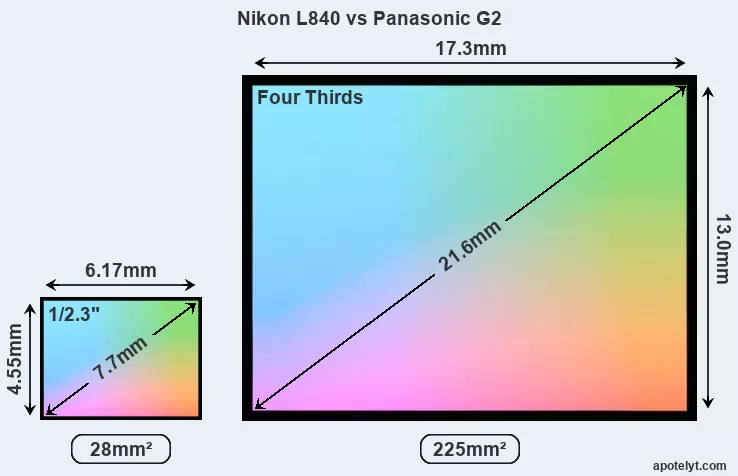
Despite having a smaller sensor, the Nikon L840 offers a higher resolution of 15.9 megapixels, compared with 12 MP of the Panasonic G2. This megapixels advantage comes at the cost of a higher pixel density and a smaller size of the individual pixel (with a pixel pitch of 1.33μm versus 4.33μm for the G2). However, it should be noted that the L840 is much more recent (by 4 years and 11 months) than the G2, and its sensor will have benefitted from technological advances during this time that make it possible to gather light more efficiently. Coming back to sensor resolution, it should be mentioned that the L840 has no anti-alias filter installed, so that it can capture all the detail its sensor resolves.
The resolution advantage of the Nikon L840 implies greater flexibility for cropping images or the possibility to print larger pictures. The maximum print size of the L840 for good quality output (200 dots per inch) amounts to 23 x 17.3 inches or 58.5 x 43.9 cm, for very good quality (250 dpi) 18.4 x 13.8 inches or 46.8 x 35.1 cm, and for excellent quality (300 dpi) 15.4 x 11.5 inches or 39 x 29.3 cm. The corresponding values for the Panasonic G2 are 20 x 15 inches or 50.8 x 38.1 cm for good quality, 16 x 12 inches or 40.6 x 30.5 cm for very good quality, and 13.3 x 10 inches or 33.9 x 25.4 cm for excellent quality prints.
The Nikon Coolpix L840 has a native sensitivity range from ISO 100 to ISO 6400. The Panasonic Lumix DMC-G2 offers exactly the same ISO settings.
Technology-wise, both cameras are equipped with CMOS (Complementary Metal–Oxide–Semiconductor) sensors. Both cameras use a Bayer filter for capturing RGB colors on a square grid of photosensors. This arrangement is found in most digital cameras.
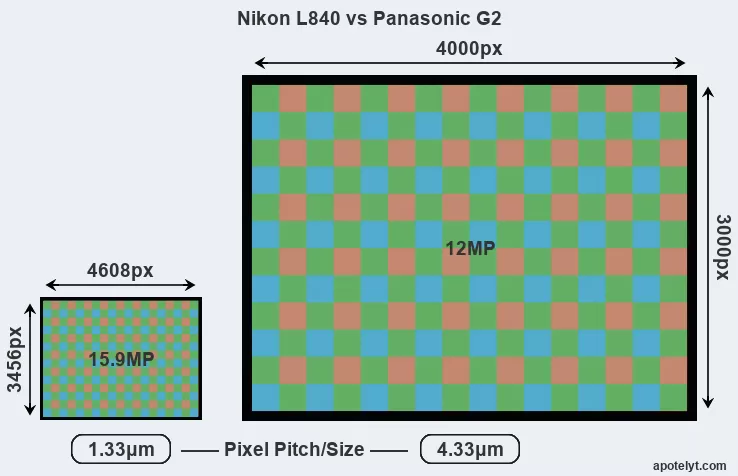
Since 2007, DXO Mark has published sensor performance measurements that have been derived using a consistent methodology. This service assesses and scores the color depth ("DXO Portrait"), dynamic range ("DXO Landscape"), and low-light sensitivity ("DXO Sports") of camera sensors, and also publishes an overall camera score. The adjacent table reports on the physical sensor characteristics and the outcomes of the DXO sensor quality tests for a sample of comparator-cameras.

| # | Camera Model |
Sensor Class |
Resolution (MP) |
Horiz. Pixels |
Vert. Pixels |
Video Format |
DXO Portrait |
DXO Landscape |
DXO Sports |
DXO Overall |
|
|---|---|---|---|---|---|---|---|---|---|---|---|
| 1. | Nikon L840 | 1/2.3 | 15.9 | 4608 | 3456 | 1080/60i | 20.2 | 11.6 | 721 | 47 | |
| 2. | Panasonic G2 | Four Thirds | 12.0 | 4000 | 3000 | 720/30p | 21.2 | 10.3 | 493 | 53 | |
| 3. | Canon SX530 | 1/2.3 | 15.9 | 4608 | 3456 | 1080/30p | 20.2 | 11.6 | 712 | 47 | |
| 4. | Canon SX520 | 1/2.3 | 15.9 | 4608 | 3456 | 1080/30p | 20.1 | 11.5 | 672 | 46 | |
| 5. | Canon SX60 | 1/2.3 | 14.2 | 4608 | 3072 | 1080/60p | 19.2 | 10.8 | 127 | 39 | |
| 6. | Nikon B600 | 1/2.3 | 15.9 | 4608 | 3456 | 1080/30p | 20.7 | 12.2 | 1095 | 52 | |
| 7. | Nikon B700 | 1/2.3 | 20.2 | 5184 | 3888 | 4K/30p | 20.4 | 11.8 | 818 | 48 | |
| 8. | Nikon B500 | 1/2.3 | 15.9 | 4608 | 3456 | 1080/60i | 20.3 | 11.7 | 810 | 48 | |
| 9. | Nikon P900 | 1/2.3 | 15.9 | 4608 | 3456 | 1080/60p | 20.2 | 11.6 | 727 | 47 | |
| 10. | Panasonic G3 | Four Thirds | 15.8 | 4592 | 3448 | 1080/60i | 21.0 | 10.6 | 667 | 56 | |
| 11. | Panasonic G10 | Four Thirds | 12.0 | 4000 | 3000 | 720/30p | 21.2 | 10.1 | 411 | 52 | |
| 12. | Panasonic GH2 | Four Thirds | 15.9 | 4608 | 3456 | 1080/60i | 21.2 | 11.3 | 655 | 60 | |
| 13. | Panasonic GH1 | Four Thirds | 12.0 | 4000 | 3000 | 1080/24p | 21.6 | 11.6 | 772 | 64 | |
| 14. | Panasonic G1 | Four Thirds | 12.0 | 4000 | 3000 | none | 21.1 | 10.3 | 463 | 53 | |
| 15. | Sony HX80 | 1/2.3 | 18.0 | 4896 | 3672 | 1080/60p | 20.4 | 11.8 | 822 | 48 | |
| 16. | Sony H400 | 1/2.3 | 19.9 | 5152 | 3864 | 720/30p | 20.1 | 11.4 | 630 | 45 | |
| 17. | Sony H200 | 1/2.3 | 15.2 | 5184 | 2930 | 720/30p | 19.9 | 11.2 | 529 | 44 | |
| Note: DXO values in italics represent estimates based on sensor size and age. | |||||||||||
Many modern cameras are not only capable of taking still images, but can also record movies. Both cameras under consideration are equipped with sensors that have a sufficiently high read-out speed for moving images, but the L840 provides a higher video resolution than the G2. It can shoot video footage at 1080/60i, while the Panasonic is limited to 720/30p.
Feature comparison
Apart from body and sensor, cameras can and do differ across a variety of features. For example, the G2 has an electronic viewfinder (1440k dots), which can be very helpful when shooting in bright sunlight. In contrast, the L840 relies on live view and the rear LCD for framing. The following table reports on some other key feature differences and similarities of the Nikon L840, the Panasonic G2, and comparable cameras.

| # | Camera Model |
Viewfinder (Type or 000 dots) |
Control Panel (yes/no) |
LCD Specifications (inch/000 dots) |
LCD Attach- ment |
Touch Screen (yes/no) |
Max Shutter Speed * |
Max Shutter Flaps * |
Built-in Flash (yes/no) |
Built-in Image Stab |
|
|---|---|---|---|---|---|---|---|---|---|---|---|
| 1. | Nikon L840 | none | n | 3.0 / 921 | tilting | n | 1/4000s | 7.4/s | Y | Y | |
| 2. | Panasonic G2 | 1440 | n | 3.0 / 460 | swivel | Y | 1/4000s | 2.6/s | Y | n | |
| 3. | Canon SX530 | none | n | 3.0 / 461 | fixed | n | 1/2000s | 1.6/s | Y | Y | |
| 4. | Canon SX520 | none | n | 3.0 / 461 | fixed | n | 1/2000s | 1.6/s | Y | Y | |
| 5. | Canon SX60 | 922 | n | 3.0 / 922 | swivel | n | 1/2000s | 6.4/s | Y | Y | |
| 6. | Nikon B600 | none | n | 3.0 / 921 | fixed | n | 1/4000s | 7.4/s | Y | Y | |
| 7. | Nikon B700 | 921 | n | 3.0 / 921 | swivel | n | 1/4000s | 5.0/s | Y | Y | |
| 8. | Nikon B500 | none | n | 3.0 / 921 | tilting | n | 1/4000s | 7.4/s | Y | Y | |
| 9. | Nikon P900 | 921 | n | 3.0 / 921 | swivel | n | 1/4000s | 7.0/s | Y | Y | |
| 10. | Panasonic G3 | 1440 | n | 3.0 / 460 | swivel | Y | 1/4000s | 4.0/s | Y | n | |
| 11. | Panasonic G10 | 202 | n | 3.0 / 460 | fixed | n | 1/4000s | 2.6/s | Y | n | |
| 12. | Panasonic GH2 | 1534 | n | 3.0 / 460 | swivel | n | 1/4000s | 3.0/s | Y | n | |
| 13. | Panasonic GH1 | 1440 | n | 3.0 / 460 | swivel | n | 1/4000s | 3.0/s | Y | n | |
| 14. | Panasonic G1 | 1440 | n | 3.0 / 460 | swivel | n | 1/4000s | 3.0/s | Y | n | |
| 15. | Sony HX80 | 638 | n | 3.0 / 922 | tilting | n | 1/2000s | 10.0/s | Y | Y | |
| 16. | Sony H400 | 210 | n | 3.0 / 460 | fixed | n | 1/2000s | 0.7/s | Y | Y | |
| 17. | Sony H200 | none | n | 3.0 / 460 | fixed | n | 1/1500s | 0.8/s | Y | Y | |
| Note: *) Information refers to the mechanical shutter, unless the camera only has an electronic one. | |||||||||||
One differentiating feature between the two cameras concerns the touch sensitivity of the rear screen. The G2 has a touchscreen, while the L840 has a conventional panel. Touch control can be particularly helpful, for example, for setting the focus point.
The G2 has an articulated screen that can be turned to be front-facing. This characteristic will be appreciated by vloggers and photographers who are interested in taking selfies. In contrast, the L840 does not have a selfie-screen.Concerning the storage of imaging data, both the L840 and the G2 write their files to SDXC cards.
Connectivity comparison
For some imaging applications, the extent to which a camera can communicate with its environment can be an important aspect in the camera decision process. The table below provides an overview of the connectivity of the Nikon Coolpix L840 and Panasonic Lumix DMC-G2 and, in particular, the interfaces the cameras (and selected comparators) provide for accessory control and data transfer.

| # | Camera Model |
Hotshoe Port |
Internal Mic / Speaker |
Microphone Port |
Headphone Port |
HDMI Port |
USB Port |
WiFi Support |
NFC Support |
Bluetooth Support |
|
|---|---|---|---|---|---|---|---|---|---|---|---|
| 1. | Nikon L840 | - | stereo / mono | - | - | micro | 2.0 | Y | Y | - | |
| 2. | Panasonic G2 | Y | stereo / mono | - | - | mini | 2.0 | - | - | - | |
| 3. | Canon SX530 | - | stereo / mono | - | - | mini | 2.0 | Y | Y | - | |
| 4. | Canon SX520 | - | stereo / mono | - | - | mini | 2.0 | - | - | - | |
| 5. | Canon SX60 | Y | stereo / mono | Y | - | mini | 2.0 | Y | Y | - | |
| 6. | Nikon B600 | - | stereo / mono | - | - | micro | 2.0 | Y | - | Y | |
| 7. | Nikon B700 | - | stereo / mono | - | - | micro | 2.0 | Y | Y | Y | |
| 8. | Nikon B500 | - | stereo / mono | - | - | micro | 2.0 | Y | Y | Y | |
| 9. | Nikon P900 | - | stereo / mono | - | - | micro | 2.0 | Y | Y | - | |
| 10. | Panasonic G3 | Y | stereo / mono | - | - | mini | 2.0 | - | - | - | |
| 11. | Panasonic G10 | Y | mono / - | - | - | mini | 2.0 | - | - | - | |
| 12. | Panasonic GH2 | Y | stereo / mono | Y | - | mini | 2.0 | - | - | - | |
| 13. | Panasonic GH1 | Y | stereo / - | Y | - | mini | 2.0 | - | - | - | |
| 14. | Panasonic G1 | Y | - / - | - | - | mini | 2.0 | - | - | - | |
| 15. | Sony HX80 | - | stereo / mono | - | - | micro | 2.0 | Y | Y | - | |
| 16. | Sony H400 | - | mono / mono | - | - | micro | 2.0 | Y | - | - | |
| 17. | Sony H200 | - | mono / mono | - | - | - | 2.0 | - | - | - |
It is notable that the L840 offers wifi support, while the G2 does not. Wifi can be a very convenient means to transfer image data to an off-camera location.
Both the L840 and the G2 have been discontinued, but can regularly be found used on ebay. The G2 was replaced by the Panasonic G3, while the L840 was followed by the Nikon B500. Further information on the features and operation of the L840 and G2 can be found, respectively, in the Nikon L840 Manual (free pdf) or the online Panasonic G2 Manual.
Review summary
So how do things add up? Is the Nikon L840 better than the Panasonic G2 or vice versa? Below is a summary of the relative strengths of each of the two contestants.

Arguments in favor of the Nikon Coolpix L840:
- More detail: Offers more megapixels (15.9 vs 12MP) with a 15% higher linear resolution.
- Maximized detail: Lacks an anti-alias filter to exploit the sensor's full resolution potential.
- Better video: Provides higher definition movie capture (1080/60i vs 720/30p).
- More detailed LCD: Has a higher resolution rear screen (921k vs 460k dots).
- Faster burst: Shoots at higher frequency (7.4 vs 2.6 flaps/sec) to capture the decisive moment.
- Ready to shoot: Has a lens built-in, whereas the G2 requires a separate lens.
- More compact: Is smaller (113x78mm vs 124x84mm) and thus needs less room in the bag.
- Longer lasting: Can take more shots (590 versus 360) on a single battery charge.
- Sharper images: Has hand-shake reducing image stabilization built-in.
- Easier file upload: Has wifi built in for automatic backup or image transfer to the web.
- Easier device pairing: Supports NFC for fast wireless image transfer over short distances.
- More affordable: Was introduced at a lower price, despite coming with a built-in lens.
- More modern: Reflects 4 years and 11 months of technical progress since the G2 launch.

Reasons to prefer the Panasonic Lumix DMC-G2:
- Better moiré control: Has an anti-alias filter to avoid artificial patterns to appear in images.
- Better image quality: Features bigger pixels on a larger sensor for higher quality imaging.
- Richer colors: The pixel size advantage translates into images with better, more accurate colors.
- More dynamic range: Larger pixels capture a wider spectrum of light and dark details.
- Better low-light sensitivity: Larger pixels means good image quality even under poor lighting.
- Easier framing: Has an electronic viewfinder for image composition and settings control.
- More flexible LCD: Has a swivel screen for odd-angle shots in portrait or landscape orientation.
- Fewer buttons to press: Has a touchscreen to facilitate handling and shooting adjustments.
- More selfie-friendly: Has an articulated screen that can be turned to be front-facing.
- More flexible: Takes interchangeable lenses and can thus be used with specialty optics.
- Better lighting: Features a hotshoe and can thus hold and trigger an external flash gun.
- More heavily discounted: Has been around for much longer (launched in March 2010).
If the count of relative strengths (bullet points above) is taken as a measure, the L840 comes out slightly ahead of the G2 (13 : 12 points). However, the relative importance of the various individual camera aspects will vary according to personal preferences and needs, so that you might like to apply corresponding weights to the particular features before making a decision on a new camera. A professional wildlife photographer will view the differences between cameras in a way that diverges from the perspective of a family photog, and a person interested in architecture has distinct needs from a sports shooter. Hence, the decision which camera is best and worth buying is often a very personal one.
How about other alternatives? Do the specifications of the Nikon L840 and the Panasonic G2 place the cameras among the top in their class? Find out in the latest Best Superzoom Camera and Best Mirrorless Interchangeable Lens Camera listings whether the two cameras rank among the cream of the crop.
In any case, while the comparison of technical specifications can provide a useful overview of the capabilities of different cameras, it says little about, for example, the shooting experience and imaging performance of the L840 and the G2 in practical situations. At times, user reviews, such as those published at amazon, address these issues in a useful manner, but such feedback is on many occasions incomplete, inconsistent, and unreliable.
Expert reviews
This is why hands-on reviews by experts are important. The table below provides a synthesis of the camera assessments of some of the best known photo-gear review sites (amateurphotographer [AP], cameralabs [CL], digitalcameraworld [DCW], dpreview [DPR], ephotozine [EPZ], photographyblog [PB]). As can be seen, the professional reviewers agree in many cases on the quality of different cameras, but sometimes their assessments diverge, reinforcing the earlier point that a camera decision is often a very personal choice.

| # | Camera Model |
AP score |
CL score |
DCW score |
DPR score |
EPZ score |
PB score |
Camera Launch |
Launch Price (USD) |
Street Price |
|
|---|---|---|---|---|---|---|---|---|---|---|---|
| 1. | Nikon L840 | .. | + + | .. | .. | 3.5/5 | 4/5 | Feb 2015 | 299 | ebay.com | |
| 2. | Panasonic G2 | .. | .. | .. | 72/100 | 4/5 | 4.5/5 | Mar 2010 | 599 | ebay.com | |
| 3. | Canon SX530 | .. | + + | .. | .. | 4/5 | 4/5 | Jan 2015 | 429 | ebay.com | |
| 4. | Canon SX520 | .. | + | .. | .. | 3.5/5 | 3.5/5 | Jul 2014 | 399 | ebay.com | |
| 5. | Canon SX60 | 3/5 | + + | .. | 75/100 | 4/5 | 4.5/5 | Sep 2014 | 549 | ebay.com | |
| 6. | Nikon B600 | .. | + | .. | .. | 3.5/5 | 3/5 | Jan 2019 | 349 | ebay.com | |
| 7. | Nikon B700 | .. | + | .. | .. | 4/5 | 4/5 | Feb 2016 | 499 | ebay.com | |
| 8. | Nikon B500 | .. | + | .. | .. | 4/5 | 3.5/5 | Jan 2016 | 299 | ebay.com | |
| 9. | Nikon P900 | .. | .. | .. | 77/100 | 4/5 | 4/5 | Mar 2015 | 599 | ebay.com | |
| 10. | Panasonic G3 | 3/5 | + + | .. | 75/100 | 4.5/5 | 5/5 | May 2011 | 599 | ebay.com | |
| 11. | Panasonic G10 | 3/5 | .. | .. | 70/100 | 4/5 | 4/5 | Mar 2010 | 499 | ebay.com | |
| 12. | Panasonic GH2 | 5/5 | + + | .. | 79/100 | 4.5/5 | 5/5 | Sep 2010 | 899 | ebay.com | |
| 13. | Panasonic GH1 | .. | + + | .. | 72/100 | 4.5/5 | 4.5/5 | Mar 2009 | 899 | ebay.com | |
| 14. | Panasonic G1 | .. | + + | .. | 70/100 | 4/5 | 4.5/5 | Sep 2008 | 599 | ebay.com | |
| 15. | Sony HX80 | .. | .. | .. | .. | .. | .. | Mar 2016 | 349 | ebay.com | |
| 16. | Sony H400 | .. | o | .. | .. | 3.5/5 | 3.5/5 | Feb 2014 | 319 | ebay.com | |
| 17. | Sony H200 | .. | .. | .. | .. | 3.5/5 | 3.5/5 | Jan 2013 | 249 | ebay.com | |
| Note: (+ +) highly recommended; (+) recommended; (o) reviewed; (..) not available. | |||||||||||
The review scores listed above should be treated with care, though. The ratings were established in reference to similarly priced cameras that were available in the market at the time of the review. A score, therefore, has to be seen in close connection to the price and market introduction time of the camera, and rating-comparisons among cameras that span long time periods or concern very differently equipped models make little sense. It should also be noted that some of the review sites have over time altered the way they render their verdicts.

Check L840 offers at
ebay.com

Check G2 offers at
ebay.com
Other camera comparisons
Did this review help to inform your camera decision process? In case you would like to check on the differences and similarities of other camera models, just make your choice using the following search menu. There is also a set of direct links to comparison reviews that other users of the CAM-parator app explored.
- Canon 4000D vs Panasonic G2
- Canon 5D Mark II vs Nikon L840
- Canon 60D vs Panasonic G2
- Canon 750D vs Nikon L840
- Contax N Digital vs Nikon L840
- Leica X Vario vs Panasonic G2
- Nikon L840 vs Panasonic GF2
- Nikon L840 vs Pentax K-30
- Nikon L840 vs Sony H400
- Olympus E-M1 II vs Panasonic G2
- Panasonic G2 vs Pentax K-3 II
- Panasonic G2 vs Sony A6500
Specifications: Nikon L840 vs Panasonic G2
Below is a side-by-side comparison of the specs of the two cameras to facilitate a quick review of their differences and common features.
| Camera Model | Nikon L840 | Panasonic G2 |
|---|---|---|
| Camera Type | Fixed lens compact camera | Mirrorless system camera |
| Camera Lens | 22.5-855mm f/3.0-6.5 | Micro Four Thirds lenses |
| Launch Date | February 2015 | March 2010 |
| Launch Price | USD 299 | USD 599 |
| Sensor Specs | Nikon L840 | Panasonic G2 |
| Sensor Technology | CMOS | CMOS |
| Sensor Format | 1/2.3" Sensor | Four Thirds Sensor |
| Sensor Size | 6.17 x 4.55 mm | 17.3 x 13.0 mm |
| Sensor Area | 28.0735 mm2 | 224.9 mm2 |
| Sensor Diagonal | 7.7 mm | 21.6 mm |
| Crop Factor | 5.6x | 2.0x |
| Sensor Resolution | 15.9 Megapixels | 12 Megapixels |
| Image Resolution | 4608 x 3456 pixels | 4000 x 3000 pixels |
| Pixel Pitch | 1.33 μm | 4.33 μm |
| Pixel Density | 56.73 MP/cm2 | 5.34 MP/cm2 |
| Moiré control | no AA filter | Anti-Alias filter |
| Movie Capability | 1080/60i Video | 720/30p Video |
| ISO Setting | 100 - 6,400 ISO | 100 - 6,400 ISO |
| DXO Sensor Quality (score) | .. | 53 |
| DXO Color Depth (bits) | .. | 21.2 |
| DXO Dynamic Range (EV) | .. | 10.3 |
| DXO Low Light (ISO) | .. | 493 |
| Screen Specs | Nikon L840 | Panasonic G2 |
| Viewfinder Type | no viewfinder | Electronic viewfinder |
| Viewfinder Field of View | 100% | |
| Viewfinder Magnification | 0.70x | |
| Viewfinder Resolution | 1440k dots | |
| LCD Framing | Live View | Live View |
| Rear LCD Size | 3.0inch | 3.0inch |
| LCD Resolution | 921k dots | 460k dots |
| LCD Attachment | Tilting screen | Swivel screen |
| Touch Input | no Touchscreen | Touchscreen |
| Shooting Specs | Nikon L840 | Panasonic G2 |
| Focus System | Contrast-detect AF | Contrast-detect AF |
| Continuous Shooting | 7.4 shutter flaps/s | 2.6 shutter flaps/s |
| Fill Flash | Built-in Flash | Built-in Flash |
| Storage Medium | SDXC cards | SDXC cards |
| Single or Dual Card Slots | Single card slot | Single card slot |
| UHS card support | no | no |
| Connectivity Specs | Nikon L840 | Panasonic G2 |
| External Flash | no Hotshoe | Hotshoe |
| USB Connector | USB 2.0 | USB 2.0 |
| HDMI Port | micro HDMI | mini HDMI |
| Wifi Support | Wifi built-in | no Wifi |
| Near-Field Communication | NFC built-in | no NFC |
| Body Specs | Nikon L840 | Panasonic G2 |
| Battery Type | Nikon 4xAA | Panasonic DMW-BLB13 |
| Battery Life (CIPA) | 590 shots per charge | 360 shots per charge |
| Body Dimensions |
113 x 78 x 96 mm (4.4 x 3.1 x 3.8 in) |
124 x 84 x 74 mm (4.9 x 3.3 x 2.9 in) |
| Camera Weight | 538 g (19.0 oz) | 428 g (15.1 oz) |

Check L840 offers at
ebay.com

Check G2 offers at
ebay.com
Did you notice an error on this page? If so, please get in touch, so that we can correct the information.

